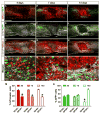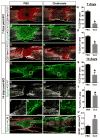Hematogenous macrophage depletion reduces the fibrotic scar and increases axonal growth after spinal cord injury
- PMID: 25461258
- PMCID: PMC4323620
- DOI: 10.1016/j.nbd.2014.10.024
Hematogenous macrophage depletion reduces the fibrotic scar and increases axonal growth after spinal cord injury
Abstract
Spinal cord injury (SCI) leads to formation of a fibrotic scar that is inhibitory to axon regeneration. Recent evidence indicates that the fibrotic scar is formed by perivascular fibroblasts, but the mechanism by which they are recruited to the injury site is unknown. Using bone marrow transplantation in mouse model of spinal cord injury, we show that fibroblasts in the fibrotic scar are associated with hematogenous macrophages rather than microglia, which are limited to the surrounding astroglial scar. Depletion of hematogenous macrophages results in reduced fibroblast density and basal lamina formation that is associated with increased axonal growth in the fibrotic scar. Cytokine gene expression analysis after macrophage depletion indicates that decreased Tnfsf8, Tnfsf13 (tumor necrosis factor superfamily members) and increased BMP1-7 (bone morphogenetic proteins) expression may serve as anti-fibrotic mechanisms. Our study demonstrates that hematogenous macrophages are necessary for fibrotic scar formation and macrophage depletion results in changes in multiple cytokines that make the injury site less fibrotic and more conducive to axonal growth.
Keywords: Axonal growth; Bone morphogenetic protein; Fibroblasts; Fibrotic scar; Hematogenous macrophages; Spinal cord injury; Tumor necrosis factor.
Copyright © 2014 Elsevier Inc. All rights reserved.
Figures







References
-
- Basso DM, et al. Basso Mouse Scale for locomotion detects differences in recovery after spinal cord injury in five common mouse strains. Journal of neurotrauma. 2006;23:635–59. - PubMed
-
- Blomster LV, et al. Mobilisation of the splenic monocyte reservoir and peripheral CX(3)CR1 deficiency adversely affects recovery from spinal cord injury. Experimental neurology. 2013;247:226–40. - PubMed
Publication types
MeSH terms
Substances
Grants and funding
LinkOut - more resources
Full Text Sources
Other Literature Sources
Medical
Molecular Biology Databases
Miscellaneous

